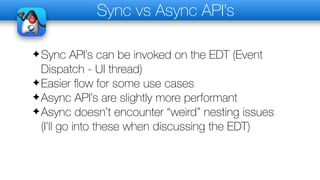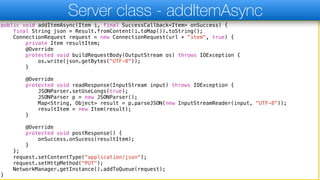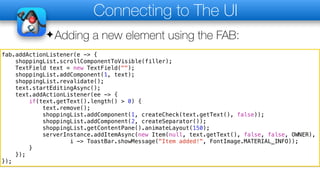Ad
Connecting to a Webservice.pdf
- 1. Connecting to a Webservice
- 2. Connecting to a Webservice ✦There are a lot of ways to do web service communication in Codename One ✦The webservice wizard is a powerful tool but I won’t be using it here because it might not fit for all use cases ✦I’ll stick to core classes and won’t wander to libraries or special syntaxes like xpath. We all know Java but some of us might not know xpath
- 3. The Item Webservice ✦We can add an item using this curl request: curl -H "Content-Type: application/json" -X PUT -d '{"name":"Item Name", "marked":false, "deleted":false, "owner":"Shai"}' http://localhost:8080/item ✦The output is: {"id":1,"name":"Item Name","marked":false,"deleted":false,"owner":"Shai"}
- 4. public class Item { private Long id; private String name; private boolean marked; private boolean deleted; private String owner; public Item(Map<String, Object> m) { this.id = Util.toLongValue(m.get("id")); this.name = (String)m.get("name"); String b = (String)m.get("marked"); this.marked = b != null && b.equals("true"); b = (String)m.get("deleted"); this.deleted = b != null && b.equals("true"); this.owner = (String)m.get("owner"); } public Map<String, Object> toMap() { HashMap<String, Object> map = new HashMap<>(); map.put("id", getId()); map.put("name", getName()); map.put("owner", getOwner()); map.put("deleted", isDeleted()); map.put("marked", isMarked()); return map; } // … } Item Class
- 5. public class Item { private Long id; private String name; private boolean marked; private boolean deleted; private String owner; public Item(Map<String, Object> m) { this.id = Util.toLongValue(m.get("id")); this.name = (String)m.get("name"); String b = (String)m.get("marked"); this.marked = b != null && b.equals("true"); b = (String)m.get("deleted"); this.deleted = b != null && b.equals("true"); this.owner = (String)m.get("owner"); } public Map<String, Object> toMap() { HashMap<String, Object> map = new HashMap<>(); map.put("id", getId()); map.put("name", getName()); map.put("owner", getOwner()); map.put("deleted", isDeleted()); map.put("marked", isMarked()); return map; } // … } Item Class Trimmed Code I trimmed a lot of boilerplate code, the constructors, getters/setters to all the elements
- 6. public Item addItemSync(Item i) { final String json = Result.fromContent(i.toMap()).toString(); ConnectionRequest request = new ConnectionRequest(url + "item", true); request.setRequestBody(json); request.setContentType("application/json"); request.setHttpMethod("PUT"); NetworkManager.getInstance().addToQueueAndWait(request); JSONParser.setUseLongs(true); if(request.getResponseData() != null) { JSONParser p = new JSONParser(); InputStream response = new ByteArrayInputStream(request.getResponseData()); try { Map<String, Object> result = p.parseJSON(new InputStreamReader(response, "UTF-8")); return new Item(result); } catch(IOException err) { Log.e(err); } } return null; } Server class - addItemSync
- 7. Sync vs Async API’s ✦Sync API’s can be invoked on the EDT (Event Dispatch - UI thread) ✦Easier flow for some use cases ✦Async API’s are slightly more performant ✦Async doesn’t encounter “weird” nesting issues (I’ll go into these when discussing the EDT)
- 8. public void addItemAsync(Item i, final SuccessCallback<Item> onSuccess) { final String json = Result.fromContent(i.toMap()).toString(); ConnectionRequest request = new ConnectionRequest(url + "item", true) { private Item resultItem; @Override protected void buildRequestBody(OutputStream os) throws IOException { os.write(json.getBytes("UTF-8")); } @Override protected void readResponse(InputStream input) throws IOException { JSONParser.setUseLongs(true); JSONParser p = new JSONParser(); Map<String, Object> result = p.parseJSON(new InputStreamReader(input, "UTF-8")); resultItem = new Item(result); } @Override protected void postResponse() { onSuccess.onSucess(resultItem); } }; request.setContentType("application/json"); request.setHttpMethod("PUT"); NetworkManager.getInstance().addToQueue(request); } Server class - addItemAsync
- 9. Fetch My Items ✦We can fetch my items using: curl http://localhost:8080/item?owner=Shai ✦The output is: [{"id":1,"name":"Item Name","marked":false,"deleted":false,"owner":"Shai"}, {"id":2,"name":"Item Name","marked":false,"deleted":false,"owner":"Shai"}, {"id":3,"name":"Item Name","marked":false,"deleted":false,"owner":"Shai"}]
- 10. public Item[] getItemsSync() { ConnectionRequest request = new ConnectionRequest(url + "item", false); request.addArgument("owner", owner); request.setContentType("application/json"); NetworkManager.getInstance().addToQueueAndWait(request); if(request.getResponseData() != null) { JSONParser p = new JSONParser(); InputStream response = new ByteArrayInputStream(request.getResponseData()); try { Map<String, Object> result = p.parseJSON(new InputStreamReader(response, "UTF-8")); List<Map<String, Object>> resultList = (List<Map<String, Object>>)result.get("root"); Item[] arr = new Item[resultList.size()]; for(int iter = 0 ; iter < arr.length ; iter++) { arr[iter] = new Item(resultList.get(iter)); } return arr; } catch(IOException err) { Log.e(err); } } return null; } Server class - getItemsSync
- 11. public void getItemsAsync(final SuccessCallback<Item[]> response) { ConnectionRequest request = new ConnectionRequest(url + "item", false) { Item[] arr; @Override protected void readResponse(InputStream input) throws IOException { JSONParser.setUseLongs(true); JSONParser p = new JSONParser(); Map<String, Object> result = p.parseJSON(new InputStreamReader(input, "UTF-8")); List<Map<String, Object>> resultList = (List<Map<String, Object>>)result.get("root"); arr = new Item[resultList.size()]; for(int iter = 0 ; iter < arr.length ; iter++) { arr[iter] = new Item(resultList.get(iter)); } } @Override protected void postResponse() { response.onSucess(arr); } }; request.addArgument("owner", owner); request.setContentType("application/json"); NetworkManager.getInstance().addToQueue(request); } Server class - getItemsAsync
- 12. Connecting to The UI ✦We can bind this to the todo list demo ✦Just add/list entries, first we need global members private static final String OWNER = "Owner"; private Server serverInstance = new Server("http://localhost:8080/", OWNER);
- 13. Connecting to The UI ✦Replace the for loop that adds the elements with: Component ip = FlowLayout.encloseCenterMiddle(new InfiniteProgress()); shoppingList.add(ip); serverInstance.getItemsAsync(items -> { ip.remove(); for(Item i : items) { if(!i.isDeleted()) { Component c = createCheck(i.getName(), i.isMarked()); c.setWidth(shoppingList.getWidth()); shoppingList.add(c); shoppingList.add(createSeparator()); } } shoppingList.revalidate(); });
- 14. Connecting to The UI ✦Replace the for loop that adds the elements with: Component ip = FlowLayout.encloseCenterMiddle(new InfiniteProgress()); shoppingList.add(ip); serverInstance.getItemsAsync(items -> { ip.remove(); for(Item i : items) { if(!i.isDeleted()) { Component c = createCheck(i.getName(), i.isMarked()); c.setWidth(shoppingList.getWidth()); shoppingList.add(c); shoppingList.add(createSeparator()); } } shoppingList.revalidate(); }); Async I have to use async or call serially here. The form hasn’t shown yet and we need to show it first before blocking progress…
- 15. Connecting to The UI ✦Adding a new element using the FAB: fab.addActionListener(e -> { shoppingList.scrollComponentToVisible(filler); TextField text = new TextField(""); shoppingList.addComponent(1, text); shoppingList.revalidate(); text.startEditingAsync(); text.addActionListener(ee -> { if(text.getText().length() > 0) { text.remove(); shoppingList.addComponent(1, createCheck(text.getText(), false)); shoppingList.addComponent(2, createSeparator()); shoppingList.getContentPane().animateLayout(150); serverInstance.addItemAsync(new Item(null, text.getText(), false, false, OWNER), i -> ToastBar.showMessage("Item added!", FontImage.MATERIAL_INFO)); } }); });
- 16. Connecting to The UI ✦Adding a new element using the FAB: fab.addActionListener(e -> { shoppingList.scrollComponentToVisible(filler); TextField text = new TextField(""); shoppingList.addComponent(1, text); shoppingList.revalidate(); text.startEditingAsync(); text.addActionListener(ee -> { if(text.getText().length() > 0) { text.remove(); shoppingList.addComponent(1, createCheck(text.getText(), false)); shoppingList.addComponent(2, createSeparator()); shoppingList.getContentPane().animateLayout(150); serverInstance.addItemAsync(new Item(null, text.getText(), false, false, OWNER), i -> ToastBar.showMessage("Item added!", FontImage.MATERIAL_INFO)); } }); }); Async I could have used sync here just as well there was no reason in terms of the UI though so I used an async call
- 19. Mini Mission © Codename One 2017 all rights reserved
- 20. Implement Check ✦The check functionality should be stored in the server ✦It should be detected in the UI and communicated as a state change to the server ✦This means creating a webservice call both in the client and the server ✦Extra credit: implement delete via swipe and make it attractive! ✦Triple credit: Port Item to use Property on the client
- 21. What did we learn? ✦How to use a JSON webservice ✦Async vs. Sync calls in NetworkManager ✦Event dispatch thread relation to networking ✦Wiring remote calls to UI
- 22. Thank You








![Fetch My Items
✦We can fetch my items using:
curl http://localhost:8080/item?owner=Shai
✦The output is:
[{"id":1,"name":"Item Name","marked":false,"deleted":false,"owner":"Shai"},
{"id":2,"name":"Item Name","marked":false,"deleted":false,"owner":"Shai"},
{"id":3,"name":"Item Name","marked":false,"deleted":false,"owner":"Shai"}]](https://image.slidesharecdn.com/connectingtoawebservice-220802134012-54a12e94/85/Connecting-to-a-Webservice-pdf-9-320.jpg)
![public Item[] getItemsSync() {
ConnectionRequest request = new ConnectionRequest(url + "item", false);
request.addArgument("owner", owner);
request.setContentType("application/json");
NetworkManager.getInstance().addToQueueAndWait(request);
if(request.getResponseData() != null) {
JSONParser p = new JSONParser();
InputStream response = new ByteArrayInputStream(request.getResponseData());
try {
Map<String, Object> result = p.parseJSON(new InputStreamReader(response, "UTF-8"));
List<Map<String, Object>> resultList = (List<Map<String, Object>>)result.get("root");
Item[] arr = new Item[resultList.size()];
for(int iter = 0 ; iter < arr.length ; iter++) {
arr[iter] = new Item(resultList.get(iter));
}
return arr;
} catch(IOException err) {
Log.e(err);
}
}
return null;
}
Server class - getItemsSync](https://image.slidesharecdn.com/connectingtoawebservice-220802134012-54a12e94/85/Connecting-to-a-Webservice-pdf-10-320.jpg)
![public void getItemsAsync(final SuccessCallback<Item[]> response) {
ConnectionRequest request = new ConnectionRequest(url + "item", false) {
Item[] arr;
@Override
protected void readResponse(InputStream input) throws IOException {
JSONParser.setUseLongs(true);
JSONParser p = new JSONParser();
Map<String, Object> result = p.parseJSON(new InputStreamReader(input, "UTF-8"));
List<Map<String, Object>> resultList = (List<Map<String, Object>>)result.get("root");
arr = new Item[resultList.size()];
for(int iter = 0 ; iter < arr.length ; iter++) {
arr[iter] = new Item(resultList.get(iter));
}
}
@Override
protected void postResponse() {
response.onSucess(arr);
}
};
request.addArgument("owner", owner);
request.setContentType("application/json");
NetworkManager.getInstance().addToQueue(request);
}
Server class - getItemsAsync](https://image.slidesharecdn.com/connectingtoawebservice-220802134012-54a12e94/85/Connecting-to-a-Webservice-pdf-11-320.jpg)














































































